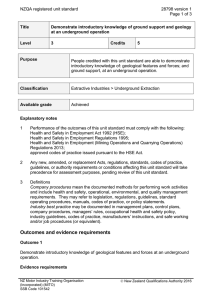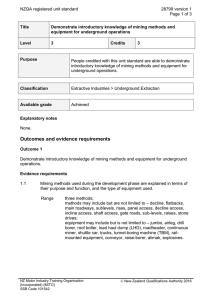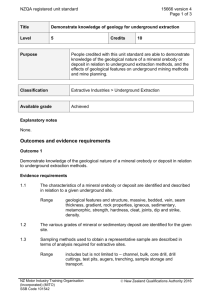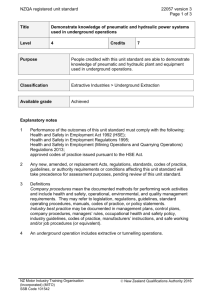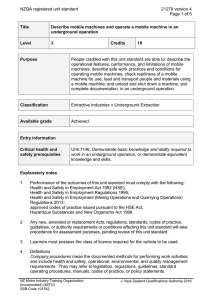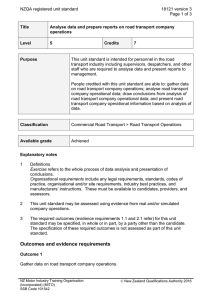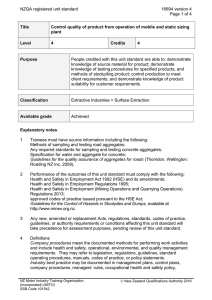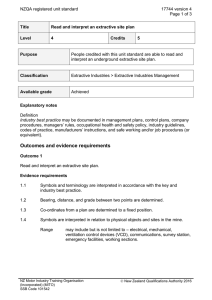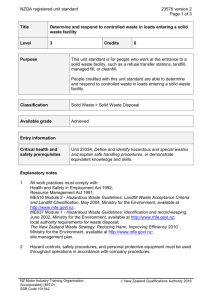NZQA registered unit standard 21278 version 3 Page 1 of 5
advertisement
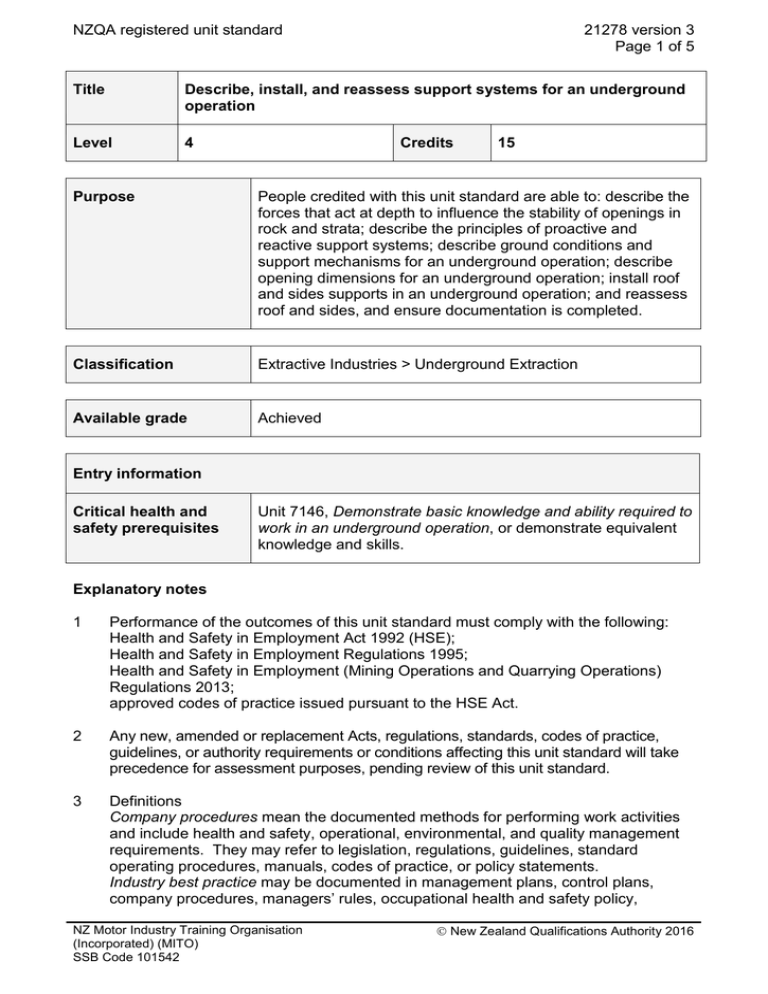
NZQA registered unit standard 21278 version 3 Page 1 of 5 Title Describe, install, and reassess support systems for an underground operation Level 4 Credits 15 Purpose People credited with this unit standard are able to: describe the forces that act at depth to influence the stability of openings in rock and strata; describe the principles of proactive and reactive support systems; describe ground conditions and support mechanisms for an underground operation; describe opening dimensions for an underground operation; install roof and sides supports in an underground operation; and reassess roof and sides, and ensure documentation is completed. Classification Extractive Industries > Underground Extraction Available grade Achieved Entry information Critical health and safety prerequisites Unit 7146, Demonstrate basic knowledge and ability required to work in an underground operation, or demonstrate equivalent knowledge and skills. Explanatory notes 1 Performance of the outcomes of this unit standard must comply with the following: Health and Safety in Employment Act 1992 (HSE); Health and Safety in Employment Regulations 1995; Health and Safety in Employment (Mining Operations and Quarrying Operations) Regulations 2013; approved codes of practice issued pursuant to the HSE Act. 2 Any new, amended or replacement Acts, regulations, standards, codes of practice, guidelines, or authority requirements or conditions affecting this unit standard will take precedence for assessment purposes, pending review of this unit standard. 3 Definitions Company procedures mean the documented methods for performing work activities and include health and safety, operational, environmental, and quality management requirements. They may refer to legislation, regulations, guidelines, standard operating procedures, manuals, codes of practice, or policy statements. Industry best practice may be documented in management plans, control plans, company procedures, managers’ rules, occupational health and safety policy, NZ Motor Industry Training Organisation (Incorporated) (MITO) SSB Code 101542 New Zealand Qualifications Authority 2016 NZQA registered unit standard 21278 version 3 Page 2 of 5 industry guidelines, codes of practice, manufacturers’ instructions, and safe working and/or job procedures (or equivalent). 4 An underground operation includes extractive or tunnelling operations. Outcomes and evidence requirements Outcome 1 Describe the forces that act at depth to influence the stability of openings in rock and strata. Evidence requirements 1.1 The forces acting on, and the behaviour of, rock at depth are described. Range 1.2 vertical, horizontal, reaction forces, stress, strain, strength, stiffness, failure. The distribution of forces around underground openings is described in terms of bed separation, abutment loads, distressed zones, and pressure arch theory. Outcome 2 Describe the principles of proactive and reactive support systems. Evidence requirements 2.1 The principles of proactive support systems are described in terms of underground operations. Range 2.2 support types include but are not limited to – roof bolts, cable bolts, friction bolts, megastrand or tensionable cable bolts (TCB), anchors, shotcrete, laminated beam, suspension or trusses, spiling bars, mesh, installation methods. The principles of reactive support systems are described in terms of underground operations. Range support types include but are not limited to – timber, props, hydraulic powered systems, poured concrete, yielding and nonyielding steel sets and arches, installation methods. NZ Motor Industry Training Organisation (Incorporated) (MITO) SSB Code 101542 New Zealand Qualifications Authority 2016 NZQA registered unit standard 21278 version 3 Page 3 of 5 Outcome 3 Describe ground conditions and support mechanisms for an underground operation. Evidence requirements 3.1 Ground conditions are described in terms of support requirement indicators. Range 3.2 may include but is not limited to – roof condition, ribs or sides condition, floor heave, spalling, guttering, ground failures, weak zones, geological structure and features, water make, bed separation, support loading, extensometer readings. Preparation and monitoring of ground prior to installation of support are described in accordance with industry best practice and company procedures. Range may include but is not limited to – trimming, barring down, scaling, sounding, visual and physical inspection, roof movement indicators (eg wedge, extensometer, strain gauge), support behaviour and loading. Outcome 4 Describe opening dimensions for an underground operation. Evidence requirements 4.1 Influences of geological conditions are described in terms of required opening dimensions. Range 4.2 may include but not is limited to – depth, faults, folding, synclinal and anticlinal structures, seam type and thickness, ore body characteristics, roof and side conditions, geologically weakened zones, voids, permeability, porosity, rock strength. Effect of opening dimensions on support system selection and installation are described. Range may include but is not limited to – roadway size and profile, pillar size, width to height ratio, strength of rock and/or strata, rock characteristics, coal extraction voids, stoping voids. Outcome 5 Install roof and sides supports in an underground operation. Evidence requirements 5.1 Equipment and materials are prepared for use in installation process in accordance with industry best practice and company procedures. NZ Motor Industry Training Organisation (Incorporated) (MITO) SSB Code 101542 New Zealand Qualifications Authority 2016 NZQA registered unit standard 5.2 Installation of support system is in accordance with industry best practice and company procedures. may include but is not limited to – shotcrete, chemical anchor bolts, cable bolts, megastrand or TCB, strap and mesh, steel sets, steel arches, poured concrete, timber supports, hydraulic supports, roof bolts (friction, expansion shell, resin bonded), grouting, shotcrete. Range 5.3 21278 version 3 Page 4 of 5 Potential hazards during installation are identified and methods to deal with them are described in accordance with industry best practice and company procedures. may include but is not limited to – unseen voids, water, gas, changing geological conditions. Range Outcome 6 Reassess roof and sides and ensure documentation is complete. Evidence requirements 6.1 Roof and sides are reassessed and any required action taken in accordance with industry best practice and company procedures. 6.3 Documentation is completed in accordance with industry best practice.and company procedures. Replacement information Planned review date This unit standard replaced unit standard 7147. 31 December 2019 Status information and last date for assessment for superseded versions Process Version Date Last Date for Assessment Registration 1 24 November 2005 Rollover and Revision 2 16 July 2010 Review 3 18 June 2015 31 December 2017 31 December 2017 N/A Consent and Moderation Requirements (CMR) reference 0114 This CMR can be accessed at http://www.nzqa.govt.nz/framework/search/index.do. Please note NZ Motor Industry Training Organisation (Incorporated) (MITO) SSB Code 101542 New Zealand Qualifications Authority 2016 NZQA registered unit standard 21278 version 3 Page 5 of 5 Providers must be granted consent to assess against standards (accredited) by NZQA, before they can report credits from assessment against unit standards or deliver courses of study leading to that assessment. Industry Training Organisations must be granted consent to assess against standards by NZQA before they can register credits from assessment against unit standards. Providers and Industry Training Organisations, which have been granted consent and which are assessing against unit standards must engage with the moderation system that applies to those standards. Requirements for consent to assess and an outline of the moderation system that applies to this standard are outlined in the Consent and Moderation Requirements (CMR). The CMR also includes useful information about special requirements for organisations wishing to develop education and training programmes, such as minimum qualifications for tutors and assessors, and special resource requirements. Comments on this unit standard Please contact the NZ Motor Industry Training Organisation (Incorporated) (MITO) info@mito.org.nz if you wish to suggest changes to the content of this unit standard. NZ Motor Industry Training Organisation (Incorporated) (MITO) SSB Code 101542 New Zealand Qualifications Authority 2016
